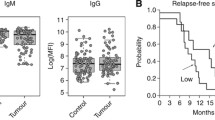Abstract
The acute phase protein, α1-acid glycoprotein (AGP), is a normal constituent of human blood (0.2–1 mg ml−1) and its glycosylation and concentration in the blood change during inflammation. In this review of our recent work, we discuss the immunomodulatory properties of AGP in connection with the structure of its carbohydrate chains.
AGP samples prepared from normal donor serum (nAGP), serum obtained during abortion (fAGP), serum of cancer patients (cAGP), and ascitic fluid of patients with stomach cancer (sAGP) were subjected to analysis. All the samples except for fAGP had five N-linked chains of the ‘complex’ type, however, the numbers of bi-, tri-, and tetra-antennary chains, as well as glycan structures terminating these chains, were different. fAGP had three N-linked chains of the lactosamine and polylactosamine type and three O-chains which were not present in AGP isolated from the other sources. The glycoforms of nAGP and sAGP that were isolated using a ConA affinity column were similar in respect to their branching, but differed in their terminal oligosaccharides. sAGP was enriched in units ending in Lex and asialoagalacto (GlcNAc-terminating) forms.
Immunomodulatory activity of different AGP preparations was tested in vitro by measuring their effect on the proliferative response of human lymphocytes stimulated by PHA, and by determining their influence on the production of IL-1, IL-2, IL-6, and TNF in the stimulated cells. nAGP was less active compared to cancer or fetal AGP in the proliferation test, but more active in affecting cytokine production. Some AGP glycoforms had opposite immunomodulatory effects.
A new approach was developed in order to clarify the role of carbohydrate chains in the biological activity of AGP. A pool of N-linked oligosaccharide chains were attached to a soluble polyacrylamide matrix. This ‘pseudoglycoprotein’ was similar to AGP in its molecular weight; in its relative amounts of tetra-, tri-, and bi-antennary chains; and in the content of mono-, di-, tri-, and tetra-sialylated-oligosaccharides. This pseudo-AGP displayed a similar activity to its parent AGP in the biological tests.
Analytical flow cytometry of leukocyte subpopulation from human peripheral blood showed that monocytes and granulocytes but not lymphocytes were the main targets for the binding of AGP and pseudo-AGP. This binding was inhibited by synthetic glycoconjugates containing mannose or sialic acid. The binding curve data suggested that there are two monocyte and granulocyte populations. These may have different carbohydrate specificities.
All the evidence provided by these studies indicate that it is the carbohydrate chains on AGP that are important in modulating the immune system and not the AGP molecule itself.
Similar content being viewed by others
References
Schmid K (1975) In The Plasma Proteins, Structure, Function and Genetic Control (Putman FWY ed) v. 1 pp 183–288. NY: Acad Press.
Bennet M, Schmid K (1980) Proc Natl Acad Sci USA 77: 6109–13.
Mackiewicz A, Pawlovski T, Mackiewicz-Pawlovska A, Wiktorowicz K, Mackiewicz S (1987) Clin Chim Acta 163: 185–90.
de Graaf TW, van der Stelt ME, Ambergen MG, van Dijk W (1993) J Exp Med 177: 657–66.
Els CM, van der Linden B, van Ommen ECR, van Dijk W (1996) Glycoconj J 13: 27–31.
Treuheit MJ, Halsall HB (1993) Chromatographia 37: 144–48.
Moule SK, Peak M, Thompson S, Turner GA (1987) Clin Chim Acta 166: 177–85.
Pos O, Oostendorp RAJ, van der Stelt ME, Scheper RJ, van Dijk W (1990) Inflammation 14: 133–41.
Shiyan SD, Nasonov VV, Bovin NV, Novikova LI, Aleshkin VA (1991) Bioorg Khim 17: 663–70.
Shiyan SD, Pavlenko AF, Belogortseva NI, Bulgakov AA, Nasonov VV, Bovin NV (1992) Abstr of Keystone Symp ‘Glycobiology II’ USA 21-27 March 1992 (J Cell Biol 19: Suppl 16D).
Shiyan SD, Nasonov VV, Bovin NV, Medvedev A (1993) Exp Onkol 15: 46–50.
Shiyan SD, Nasonov VV, Bovin NV, Novikova LI, Aleshkin VA, Lutov AG (1993) Exp Onkol 15: 53–63.
Shiyan SD, Pukhalsky AL, Toptigina AP, Nasonov VV, Bovin NV (1994) Bioorg Khim 20: 994–1000.
Shiyan SD, Nasonov VV, Bovin NV, Aleshkin VA, Novikova LI, Lutov AG (1994) Bioorg Khim 20: 1125–31.
Pukhalsky AL, Toptygina AL, Kalashnikova EV, Shiyan SD, Nasonov VV, Bovin NV, Lutov AG, Bayrushin FT (1994) Bull Exp Biol Med 7: 71–73.
Shiyan SD, Khaidukov SV, Pukhalsky AL, Toptygina AP, Bovin NV (1996) Gematol Transfusiol 41: 24–29.
Boutten A, Dehoux M, Deschenes M, Rouzeau J-D, Bories PN, Duran G (1992) Eur J Immunol 22: 2687–95.
Bovin NV, Korchagina EY, Zemlynukhina TV, Byramova, Galanina OE, Zemlyakov AE, Ivanov AE, Zubov VP, Mochalova LV (1993) Glycoconj J 10: 142–51.
Shiyan SD, Nasonov VV, Markin VA, Belianchikov IM (1988) Bioorg Khim 14: 1197–207.
Tomiya N, Awaya J, Kurono M, Endo S, Arata Y, Takahashi N (1988) Anal Biochem 171: 73–90.
Bierhuizen MN, de Witt M, Govers CARL, Ferwerda W, Koeleman C, Pos O (1988) Eur J Biochem 175: 387–94.
Pavlenko AF, Belogortseva NI, Bulgakov AA, Beznaev AN, Ovodov YS (1989) Bioorg Khim 15: 816–20.
Seta N, Tissot B, Forestier F, Feger J, Daffos F, Durand G (1991) Clinica Chimica Acta 203: 167–176.
Sokolov KV, Byramova NE, Mochalova L, Tuzikov AB, Shiyan SD, Bovin NV, Nabiev IR (1993) Appl Spectr 47: 535–38.
Vasson MP, Roch-Arveiller M, Couders R, Baguet JK, Raichvard D (1994) Clin Chim Acta 224: 65–71.
Pukhalsky AL, Shiyan SD, Kalashnikova EV, Bovin NV (1997) Bull Exp Biol Med 10 (in press).
Ruff MR, Gifford DE (1981) in Lymphokines (Pick E ed) pp 235–41. NY: Acad Press.
Stahl PD, Rodman JS, Miller MJ, Schlesinger PH (1978) Proc Natl Acad Sci USA 75: 1399–403.
Gessl A, Boltz-Nitulesscu G, Wiltschke C, Holzinger C, Nemet H, Pernerstorfer T, Forster O (1990) J Immunol 142: 4372–77.
Pimpaneau V, Midouz P, Duran G, de Baetselier P, Monsigny M, Roche AC (1989) Glycoconj J 6: 561–74.
(Editor: copies of papers 9 and 14, dealing in more detail with the carbohydrate analysis of AGP, are available from the publishers.)
Author information
Authors and Affiliations
Rights and permissions
About this article
Cite this article
Shiyan, S.D., Bovin, N.V. Carbohydrate composition and immunomodulatory activity of different glycoforms of α1-acid glycoprotein. Glycoconj J 14, 631–638 (1997). https://doi.org/10.1023/A:1018544711767
Issue Date:
DOI: https://doi.org/10.1023/A:1018544711767




